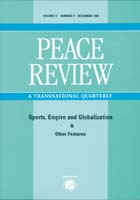

Peace Review: A Journal of Social Justice
Special Edition: "Subcultures and Political Resistance "
(16:4, Winter 2004)
Guest Editors
Jeffrey Paris, University of San Francisco
Michael Ault, California State University, Bakersfield
Table of Contents
Essays
Jeffrey Paris and Michael Ault, "Subcultures and Political Resistance."
Comments on how subcultures, punks, beats, mods, metalheads, ravers, hippies
interfere as an actual mechanism of semantic disorder and a kind of temporary
blockage in the system of representation in politics. Analysis on the noise
produced by subcultures and the influences in the cultural studies and social
innovation; Emergence of subcultures to carve out individualized local spaces
and encouragement and protection for their signifying practices of resistance;
Transformation of subcultures toward a culture and politics of fusion and
heterogeneity made possible by sea change from movement to movements, the
anti-globalization movement.
Alan O'Connor, "The Sociology of Youth Subcultures." Comments on the main theme in the sociology of youth subcultures which is the relation between social class and everyday experience. Significant effects of a system of social class on the lives of the people; Significant differences between different societies in the world in spite of talk about globalization; Argumentation on the creation of subcultures by those youth who cannot achieve according to social norms, and cannot do well in school or find a good job;
Oliver Marchart, "New Protest Formations and Radical Democracy." Comments on the new political actor called alternately as "anti-globalization movement," "global protest movement," "global justice movement," or "movement for movements" that has entered the scene of global politics and has developed a global subculture. Analysis on the political formation of subcultures; Renewed reflection on the political relevance of subcultural and youth-cultural movements; Resistance through style paradigm of early subcultural studies; Subcultural theorists blindness regarding macro-politics due to the fact that they were not interested in how the subcultural activity would become a part of the oppositional action.
Graham St. John, "Counter-Tribes, Global Protest and Carnivals of Reclamation." Discusses on the signal issue protest movement "We Are Everywhere" by the Reclaim the Street activists when they recount the first London events, in which they have effectively recollected what became a template for popular resistance in the emergent movement of movements. Contribution of the issue to discussions of methods through which global anxieties are addressed and redressed in local acts of resistance; Proliferation of anti-corporate struggle necessitates the search for useful models through which to comprehend cultures of resistance and youth activism; Involvement of behaviors simultaneously tactical and festal, a contiguity most apparent in the carnival of protest;
George McKay, "Subcultural Innovations in the Campaign for Nuclear Disarmament." Discusses on the instances of subcultural innovations within the social and political spaces Campaign for Nuclear Disarmament (CND) helped make available during its two high periods of activity and membership. Campaign against hydrogen bomb in 1950; Campaign against U.S.-controlled cruise missiles; Acknowledgement on the limited orthodox subculture theory; Responses from cultural and critical members and activists to the nuclear deconstruction of rationality. Four primary cultural/social innovations linked to CND.
Helen Reddington, "The Forgotten Revolution of Female Punk Musicians in the 1970s." Discusses on the revolution made by subculture women punk who were captured the essence of unemployed, bored youth due to the misbelief that a wonderful Land of Equality lay before them. Association between lack of musical skills and street credibility; Problem with saving money to buy instruments; Protests made by politically aware women musicians who were barbed but whose music was unchallenging.
Elke Zobl, "Revolution Grrrl and Lady Style, Now!." Argues the endurance of trend toward feminist opinions and self-identification in the U.S. based on the emergence of the Riot Grrrl movement and Ladyfests. Catalysts of the movements; Medium of keeping feminist ideologies and practices of cultural resistance; Magnitude of implications and successes of the activity.
Dylan Clark, "Waker Cells and Subcultural Resistance." Discusses the sentiment of Black Cat Cafe, a cooperatively owned and run restaurant in Seattle, Washington where punks practiced and elaborated a defiant culture, a life and politics resisting the system. Potency of the subculture trend; Transformations in subculture practice; Contribution of the movement to orchestration of anarchist principles.
Karenza Moore, "A Commitment to Clubbing." Explores the commitment that many people hold towards clubbing. Backgrounds of clubbers; Dream of dance club culture; Promotion of tolerance and celebration of difference.
Ideas
Robert K. Bothwell and Emily Kennison, The Authoritarian Personality and Attitudes Toward War
Tom Crumpacker, Birds of Guantánamo
Gabrielle Frölich, Discrimination in German Immigration
Charles Ongadi Nyambuga, Media, Ethnicity and Conflict
Nicholas Patler, From Pathan to Palestine
Roberto Toledo, How Congress Has Legitimated Latin American Counter-Insurgency
Peace Profile: S.P. Udayakumar, Jayaprakash Narayan
Peace Review Table of Contents.